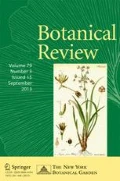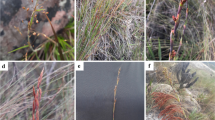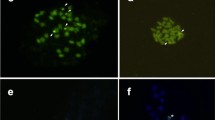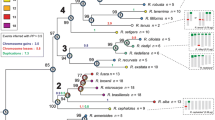Abstract
Sedges (Carex: Cyperaceae) exhibit remarkable agmatoploid chromosome series between and within species. This chromosomal diversity is due in large part to the structure of the holocentric chromosomes: fragments that would not be heritable in organisms with monocentric chromosomes have the potential to produce viable gametes in organisms with holocentric chromosomes. The rapid rate of chromosome evolution in the genus and high species diversification rate in the order (Cyperales Hutch., sensu Dahlgren) together suggest that chromosome evolution may play an important role in the evolution of species diversity in Carex. Yet the other genera of the Cyperaceae and their sister group, the Juncaceae, do not show the degree of chromosomal variation found in Carex, despite the fact that diffuse centromeres are a synapomorphy for the entire clade. Moreover, fission and fusion apparently account for the majority of chromosome number changes in Carex, with relatively little duplication of whole chromosomes, whereas polyploidy is relatively important in the other sedge genera. In this paper, we review the cytologic and taxonomic literature on chromosome evolution in Carex and identify unanswered questions and directions for future research. In the end, an integration of biosystematic, cytogenetic, and genomic studies across the Cyperaceae will be needed to address the question of what role chromosome evolution plays in species diversification within Carex and the Cyperaceae as a whole.
Similar content being viewed by others
Literature Cited
Albertson, D. G. 1993. Mapping chromosome rearrangement breakpoints to the physical map of Caenorhabditis elegans by fluorescent in situ hybridization. Genetics 134: 211–219.
Ayala, F. J. & M. Coluzzi. 2005. Chromosome speciation: humans, Drosophila, and mosquitoes. Proc. Natl. Acad. U.S.A. 102: 6535–6542.
Battaglia, E. & J. W. Boyes. 1955. Post-reductional meiosis: its mechanism and causes. Caryologia 8: 87–134.
Brown, R. C. & B. E. Lemmon. 2000. The cytoskeleton and polarization during pollen development in Carex blanda (Cyperaceae). American J. Bot. 87: 1–11.
Buchwitz, B. J., K. Ahmad, L. L. Moore, M. B. Roth & S. Henikoff. 1999. A histone-H3-like protein in C. elegans. Nature (London) 401: 547–548.
Burnham, K. P., & D. R. Anderson. 2002. Model selection and multimodel inference: a practical information-theoretic approach. Springer, New York.
Butlin, R. K. 2005. Recombination and speciation. Mol. Ecol. 14: 2621–2635.
Cayouette, J. & P. M. Catling. 1992. Hybridization in the genus Carex with special reference to North America. The Botanical Review 58: 351–438.
Cayouette, J. & P. Morisset. 1985. Chromosome studies on natural hybrids between maritime species of Carex (sections Phacocystis and Cryptocarpae) in northeastern North America, and their taxonomic implications. Canadian J. Bot. 63: 1957–1982.
————. 1986a. Chromosome studies on the Carex salina complex (Cyperaceae, section Cryptocarpae) in northeastern North American. Cytologia 51: 817–856.
————. 1986b. Chromosome studies on Carex paleacea Wahl., Carex nigra (L.) Reichard, and Carex aquatilis Wahl. in northeastern North America. Cytologia 51: 857–884.
Coyne, J. A. & H. A. Orr. 2004. Speciation. Sinauer Associates, Sunderland.
Crins, W. J. 1990. Phylogenetic considerations below the sectional level in Carex. Can. J. Bot. 68: 1433–1440.
Crins, W. J. & P. W. Ball. 1988. Sectional limits and phylogenetic considerations in Carex section Ceratocystis (Cyperaceae). Brittonia 40: 38–47.
Dahlgren, R., H. T. Clifford, & P. Yeo. 1985. The families of the Monocotyledons: structure, evolution, and taxonomy. Springer-Verlag, Berlin.
Davies, E. W. 1956. Cytology, evolution and origin of the aneuploid series in the genus Carex. Hereditas 42: 349–365.
De Castro, D. 1950. Notes on two cytological problems of the genus Luzula DC. Genét. Ibér. 2: 201–209.
Dernburg, A. F. 2001. Here, there, and everywhere: kinetochore function on holocentric chromosomes. J. Cell Biol. 153: F33–F38.
Faulkner, J. S. 1972. Chromosome studies on Carex section Acutae in north-west Europe. Bot. J. Linn. Soc. 65: 271–301.
————. 1973. Experimental hybridization of north-west European species in Carex section Acutae (Cyperaceae). Bot. J. Linn. Soc. 67: 233–253.
Flach, M. 1966. Diffuse centromeres in a dicotyledoneous plant. Nature (London) 209: 1369–1370.
Ford, B. A., M. Iranpour, R. F. C. Naczi, J. R. Starr & C. A. Jerome. 2006. Phylogeny of Carex subg. Vignea (Cyperaceae) based on non-coding nrDNA sequence data. Syst. Bot. 31: 70–82.
Grant, V. E. 1981. Plant Speciation, Edition 2. Columbia University Press, New York.
Greilhuber, J. 1995. Chromosomes of the monocotyledons (general aspects). Pp. 379–414 in P. J. Rudall, P. J. Cribb, D. F. Culer & C. J. Humphries (ed.), Monocotyledons: Systematics and Evolution. Royal Botanic Gardens, Kew.
Guerra, M. & M. A. García. 2004. Heterochromatin and rDNA sites distribution in the holocentric chromosomes of Cuscuta approximata Bab. (Convolvulaceae). Genome 47: 134–140.
Håkansson, A. 1954. Meiosis and pollen mitosis in x-rayed and untreated spikelets of Eleocharis palustris. Hereditas (Lund) 15: 325–345.
Harmon, L. J., & J. B. Losos. 2005. The effect of intraspecific sample size on type I and type II error rates in comparative studies. Evolution 59: 2705–2710.
Haskell, G. 1952. Polyploidy, ecology and the British Flora. J. Ecol. 40: 265–282.
Heilborn, O. 1924. Chromosome numbers and dimensions, species-formation and phylogeny in the genus Carex. Hereditas 5: 129–216.
————. 1928. Chromosome studies in Cyperaceae. Hereditas 11: 182–192.
————. 1932. Aneuploidy and polyploidy in Carex. Svensk Bot. Tidskr. 26: 137–145.
Hey, J. 2004. What's so hot about recombination hotspots? PLoS Biology 2: e190.
Hipp, A. L. 2007. Non-uniform processes of chromosome evolution in sedges (Carex: Cyperaceae). Evolution 61:2175–2194.
Hipp, A. L., P. E. Rothrock & A. A. Reznicek. 2006. Phylogeny and classification of Carex section Ovales (Cyperaceae). International Journal of Plant Sciences 167: 1029–1048.
Hipp, A. L., P. E. Rothrock, A. A. Reznicek & P. E. Berry. 2007. Changes in chromosome number associated with speciation in sedges: A phylogenetic study in Carex section Ovales (Cyperaceae). In J. T. Columbus, E. A. Friar, J. M. Porter, L. M. Prince and M. G. Simpson, eds. Monocots: Comparative biology and evolution (Poales). Aliso 23:193–203.
Hoshino, T. 1981. Karyomorphological and cytogenetical studies on aneuploidy in Carex. J. Sci. HIroshima Univ., Ser. B, Div. 2, Bot. 17: 155–238.
————. 1992. Cytogeographical study of four aneuploids of Carex oxyandra Kudo in Japan. Bot. Mag. (Tokyo) 105: 639–648.
Hoshino, T. & T. Shimizu. 1986. Cytological studies on degenerative nuclei at pollen development of Carex ciliato-marginata. Bot. Mag. (Tokyo) 99: 185–190.
Hoshino, T. & K. Okamura. 1994. Cytological studies on meiotic configurations on intraspecific aneuploids of Carex blepharicarpa (Cyperaceae) in Japan. Journal of Plant Research 107: 1–8.
Hoshino, T. & A. Onimatsu. 1994. Cytological studies of Carex duvaliana (Cyperaceae) with special reference to meiotic configurations of intraspecific aneuploids. J. Jap. Bot. 69: 37–41.
Hoshino, T. & M. J. Waterway. 1994. Cytogeography and meiotic chromosome configurations of six intraspecific aneuploids of Carex conica Boott (Cyperaceae) in Japan. Journal of Plant Research 107: 131–138.
Hoshino, T., K. Aosaki & A. Onimatsu. 1993. Cytological studies of Carex stenostachys (Cyperaceae) with special reference to meiotic configurations in intraspecific aneuploids. La Kromosomo II 71–72: 2451–2455.
Hoshino, T., S. Hayashi & A. Onimatsu. 1994. Meiotic chromosome configurations of intraspecific aneuploids of Carex sikokiana (Cyperaceae) in Japan. J. Jap. Bot. 69: 142–146.
Hoshino, T., K. Furuta & H. Hatooka. 1999. Pollen development and postreductional meiosis in Carex. Abstract, XVI International Botanical Congress.
Huelsenbeck, J. P., R. Nielsen, & J. P. Bollback. 2003. Stochastic mapping of morphological characters. Systematic Biology 52: 131–158.
Juel, H. O. 1900. Beiträge zur Kenntnis der Tetradenteilung. Jahrb. Wiss. Bot. 35: 626–659.
La Cour, L. F. 1952. The Luzula system analyzed by X-ray. Heredity 6: 77–81.
Leitch, I. J. & M. D. Bennett. 2004. Genomic downsizing in polyploid plants. Biol. J. Linn. Soc. 82: 651–663.
Lexer, C., M. E. Welch, J. L. Durphy & L. H. Rieseberg. 2003. Natural selection for salt tolerance quantitative trait loci (QTLs) in wild sunflower hybrids: Implications for the origin of Helianthus paradoxus, a diploid hybrid species. Mol. Ecol. 12: 1225–1235.
Löve, A. E. 1981. Chromosome number reports LXXIII. Taxon 30: 829–861.
————. 1982. IOPB chromosome number reports LXXV. Taxon 31: 342–368.
Löve, A., D. Löve & M. Raymond. 1957. Cytotaxonomy of Carex section Capillares. Can. J. Bot. 35: 715–761.
Luceño, M. 1993. Chromosome studies on Carex (L.) section Mitratae Kükenth. (Cyperaceae) in the Iberian Peninsula. Cytologia 58: 321–330.
————. 1994. Cytotaxonomic studies in Iberian, Balearic, North African, and Macaronesian species of Carex (Cyperaceae): II. Can. J. Bot. 72: 587–596.
Luceño, M. & S. Castroviejo. 1991. Agmatoploidy in Carex laevigata (Cyperaceae): Fusion and fission of chromosomes as the mechanism of cytogenetic evolution in Iberian populations. Pl. Syst. Evol. 177: 149–160.
————. 1993. Cytotaxonomic studies in the sections Spirostachyae (Drejer) Bailey and Ceratocystis Dumort. of the genus Carex L. (Cyperaceae), with special reference to Iberian and North Aftrican taxa. Bot. J. Linn. Soc. 112: 335–350.
Luceño, M., A. L. L. Vanzela & M. Guerra. 1998. Cytotaxonomic studies in Brazilian Rhynchospora (Cyperaceae), a genus exhibiting holocentric chromosomes. Can. J. Bot. 76: 440–449.
Lutzoni, F., M. Pagel, & V. Reeb. 2001. Major fungal lineages are derived from lichen symbiotic ancestors. Nature 411: 937–940.
Maddox, P. S., K. Oegema, A. Desai, & I. M. Cheeseman. 2004. “Holo”er than thou: chromosome segregation and kinetochore function in C. elegans. Chromosome Res. 12: 641–653.
Magallon, S. A. & M. J. Sanderson. 2001. Absolute diversification rates in angiosperm clades. Evolution 55: 1762–1780.
Malheiros-Gardé, N. & A. Gardé. 1950. Chromosome number in Luzula multiflora Lej. Genét Ibér. 4: 91–94.
Martins, E. P., and T. F. Hansen. 1997. Phylogenies and the comparative method: A general approach to incorporating phylogenetic information into analysis of interspecific data. American Naturalist 149: 646–667.
Murphy, W. J., D. M. Larkin, A. Everts-van der Wind, G. Bourque, G. Tesler, L. Auvil, J. E. Beever, B. P. Chowdhary, F. Galibert, L. Gatzke, C. Hitte, S. N. Meyers, D. Milan, E. A. Ostrander, G. Pape, H. G. Parker, T. Raudsepp, M. B. Rogatcheva, L. B. Schook, L. C. Skow, M. Welge, J. E. Womack, S. J. O'Brien, P. A. Pevzner, & H. A. Lewin. 2005. Dynamics of mammalian chromosome evolution inferred from multispecies comparative maps. Science (Wash. D. C.) 309: 613–617.
Naczi, R. F. C. 1992. Systematics of Carex Section Griseae (Cyperaceae). Botany. Ph.D. Dissertation, University of Michigan, Ann Arbor.
————. 1999. Chromosome numbers of some eastern North American species of Carex and Eleocharis (Cyperaceae). Contr. Univ. Michigan Herbarium 22: 105–119.
Nagaki, K., K. Kashihara & M. Murata. 2005. Visualization of diffuse centromeres with centromere-specific histone H3 in the holocentric plant Luzula nivea. Pl. Cell 17: 1886–1893.
Nijalingappa, B. H. M. & D. L. Bai. 1990. Cytological studies in some South Indian species of Carex. Cytologia 55: 373–380.
Nishikawa, K., Y. Furuta & K. Ishitobi. 1984. Chromosomal evolution in genus Carex as viewed from nuclear DNA content, with special reference to its aneuploidy. Jap. J. Gen. 59: 465–472.
Nokkala, S., A. Laukkanen & C. Nokkala. 2002. Mitotic and meiotic chromosomes in Somatochlora metallica (Cordulidae, Odonata). The absence of localized centromeres and inverted meiosis. Hereditas 136: 7–12.
Pagel, M. 1997. Inferring evolutionary processes from phylogenies. Zoologica Scripta 26: 331–348.
————. 1999. The maximum likelihood approach to reconstructing ancestral character states of discrete characters on phylogenies. Syst. Biol. 48: 612–622.
Pardo-Manuel de Villena, F., & C. Sapienza. 2001. Female meiosis drives karyotypic evolution in mammals. Genetics 159: 1179–1189.
Pazy, B. & U. Plitmann. 1994. Holocentric chromosome behaviour in Cuscuta (Cuscutaceae). Pl. Syst. Evol. 191: 105–109.
Perez, R., J. S. Rufas, J. A. Suja, J. Page & F. Panzera. 2000. Meiosis in holocentric chromosomes: Orientation and segregation of an autosome and sex chromosomes in Triatoma infestans (Heteroptera). Chromosome Research 8: 17–25.
Reznicek, A. A. 1990. Evolution in sedges (Carex, Cyperaceae). Can. J. Bot. 68: 1409–1432.
Rieseberg, L. H. 2001. Chromosomal rearrangements and speciation. Trends Ecol. Evol. 16: 351–358.
Roalson, E. H. 2008. A synopsis of chromosome number variation in the Cyperaceae. The Botanical Review 74:209–393.
Roalson, E. H., A. G. McCubbin & R. Whitkus 2007. Chromosome evolution in the Cyperales. In J. T. Columbus, E. A. Friar, J. M. Porter, L. M. Prince & M. G. Simpson (eds.), Monocots: comparative biology and evolution (Poales). Aliso 23:62–71.
Roalson, E. H., J. T. Columbus & E. A. Friar. 2001. Phylogenetic relationships in Cariceae (Cyperaceae) based on ITS (nrDNA) and trnT-L-F (cpDNA) region sequences: Assessment of subgeneric and sectional relationships in Carex with emphasis on section Acrocystis. Syst. Bot. 26: 318–341.
Rothrock, P. E. & A. A. Reznicek. 1996. Chromosome numbers in Carex section Ovales (Cyperaceae) from Eastern North America. Sida 17: 251–258.
————. 1998. Chromosome numbers in Carex section Ovales (Cyperaceae): Additions, variations, and corrections. Sida 18: 587–592.
Schmid, B. 1982. Karyology and hybridization in the Carex flava complex in Switzerland. Feddes Repert. 93: 23–59.
Sharma, A. K. & A. K. Bal. 1956. A cytological investigation of some members of the family Cyperaceae. Fyton 6: 7–22.
Sheikh, S. A., K. Kondo & Y. Hoshi. 1995. Study of diffused centromeric nature of Drosera chromosomes. Cytologia 60: 43–47.
Stebbins, G. L. 1950. Variation and Evolution in Plants. Columbia University Press, New York.
Tanaka, N. 1937. Chromosome studies in Cyperaceae, I. Cytologia, Fujii Jubilee Volume: 814–821.
————. 1939. Chromosome studies in Cyperaceae, IV. Chromosome numbers of Carex species. Cytologia 10: 51–58.
————. 1940a. Chromosome studies in Cyperaceae, VI. Cytologia 10: 348–362.
————. 1940b. Chromosome studies in Cyperaceae, VIII: Meiosis in diploid and tetraploid forms of Carex siderosticta Hance. Cytologia 10: 282–310.
————. 1940c. Chromosome studies in Cyperaceae, X: Aneuploid plants of Carex multifolia Ohwi. Botanic Magazine (Tokyo) 54: 438–446.
————. 1941a. Chromosome studies in Cyperaceae, XI. Jap. J. Bot. 11: 213–219.
————. 1941b. Chromosome studies in Cyperaceae, 15. Bot. Mag. (Tokyo) 55: 218–225.
————. 1948. The problem of aneuploidy (Chromosome studies in Cyperaceae, with special reference to the problem of aneuploidy). Biological Contributions in Japan 4: 1–327.
————. 1949. Chromosome studies in the genus Carex with special reference to aneuploidy and polyploidy. Cytologia 15: 15–29.
Tanaka, N. & N. Tanaka. 1977. Chromosome studies in Chionographis (Liliaceae). I. On the holokinetic nature of chromosomes in Chionographis japonica Maxim. Cytologia 42: 754–763.
Turner, T. L., M. W. Hahn & S. V. Nuzhdin. 2005. Genomic Islands of Speciation in Anopheles gambiae. PLoS Biology 3: e285.
Vanzela, A. L. L., M. Luceño & M. Guerra. 2000. Karyotype evolution and cytotaxonomy in Brazilian species of Rhynchospora Vahl (Cyperaceae). Bot. J. Linn. Soc. 134: 557–566.
Wahl, H. A. 1940. Chromosome numbers and meiosis in the genus Carex. Am. J. Bot. 27: 458–470.
Wang, B. & A. H. Porter. 2004. An AFLP-based interspecific linkage map of sympatric, hybridizing Colias butterflies. Genetics 168: 215–225.
Waterway, M. J., T. Hoshino & T. Masaki. 2008. Phylogeny, species richness, and ecological specialization in Cyperaceae tribe Cariceae. Botanical Review (in press).
White, M. J. D. 1978. Modes of Speciation. W.H. Freeman & Co., New York.
Whitkus, R. 1981. Chromosome numbers of some northern New Jersey carices. Rhodora 83: 461–464.
————. 1988. Experimental hybridization among chromosome races of Carex pachystachya and the related species Carex macloviana and Carex preslii (Cyperaceae). Syst. Bot. 13: 146–153.
————. 1991. Chromosome counts of Carex section Ovales. Bot. Gaz. 152: 224–230.
Yan-Cheng, T. & X. Qiu-Yun. 1989. Cytological studies of Carex siderosticta Hance (Cyperaceae) and its importance in phytogeography. Cathaya 1: 49–60.
Yano, O. & T. Hoshino. 2005. Molecular phylogeny and chromosomal evolution of Japanese Schoenoplectus (Cyperaceae), based on ITS and ETS 1f sequences. Acta Phytotax. Geobot. 56: 183–195.
Yano, O., T. Katsuyama, H. Tsubota & T. Hoshino. 2004. Molecular phylogeny of Japanese Eleocharis (Cyperaceae) based on ITS sequence data, and chromosomal evolution. Journal of Plant Research 117: 409–419.
Acknowledgements
The authors thank the organizers of the Cyperaceae: Cariceae symposium at the XVII International Botanical Congress (2005)—Bruce Ford, Matthias Hendrichs, and Julian Starr—for inviting us to participate, and Wayt Thomas, Julian Starr, and Tony Reznicek for handling the manuscripts for the proceedings. Rita Hassert, Nancy Faller, and Jaime Weber of The Morton Arboretum provided substantial help in obtaining references for this paper. Library access provided through associate positions in the Botany Departments of The Field Museum and The University of Wisconsin–Madison were extremely helpful. This paper has benefited from discussions with and feedback from Clement Hamilton, Takuji Hoshino, and Richard Whitkus, as well as comments on this paper from Tony Reznicek and two anonymous reviewers.
Author information
Authors and Affiliations
Corresponding author
Rights and permissions
About this article
Cite this article
Hipp, A.L., Rothrock, P.E. & Roalson, E.H. The Evolution of Chromosome Arrangements in Carex (Cyperaceae). Bot. Rev 75, 96–109 (2009). https://doi.org/10.1007/s12229-008-9022-8
Published:
Issue Date:
DOI: https://doi.org/10.1007/s12229-008-9022-8




